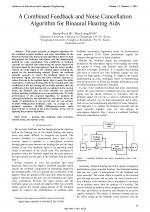| 3/2011 - 6 |
A Combined Feedback and Noise Cancellation Algorithm for Binaural Hearing AidsLEE, H.-W. |
| Extra paper information in |
| Click to see author's profile in |
| Download PDF |
Author keywords
hearing aids, feedback, noise reduction, acoustic beam, microphone array
References keywords
hearing(14), aids(14), feedback(12), processing(7), cancellation(7), adaptive(7), speech(5), signal(5), audio(4), acoustic(4)
Blue keywords are present in both the references section and the paper title.
About this article
Date of Publication: 2011-08-31
Volume 11, Issue 3, Year 2011, On page(s): 35 - 40
ISSN: 1582-7445, e-ISSN: 1844-7600
Digital Object Identifier: 10.4316/AECE.2011.03006
Web of Science Accession Number: 000296186700006
SCOPUS ID: 80055079154
Abstract
This paper proposes an adaptive algorithm for the combined acoustic feedback and noise cancellation in the binaural hearing aids. The proposed algorithm is based on dual microphones for feedback cancellation and the beamforming method for noise cancellation. The coefficients of feedback canceller are updated after subtracting the speech signal from the input signal by dual microphones. And the noise canceller reduces the noise signal in the residual signal excluding the speech by the beamforming method. Firstly, the feedback canceller operates to cancel the feedback signal in the microphone signal, and then the noise canceller operates to reduce the noise in the residual signal. Also, to assure the stable convergence of binaural hearing aids in the training mode, the coefficients of the left hearing aid are firstly updated, then the coefficients of the right hearing aid are updated. In the normal mode, the feedback and the noise canceller are operated without updating coefficients except an unstable case. To verify performances of the proposed algorithm, we analyzed its convergence behavior and simulated for real speech. From the results of simulations, it was proved that we can advance 14.43dB SFR(speech-to-feedback ratio) on average in the feedback canceller, 10.19dB SNR(speech-to-noise ratio) improvement on average in the noise canceller, in the case of applying the proposed algorithm. |
| References | | | Cited By |
Web of Science® Times Cited: 3 [View]
View record in Web of Science® [View]
View Related Records® [View]
Updated 2 weeks, 6 days ago
SCOPUS® Times Cited: 3
View record in SCOPUS® [Free preview]
View citations in SCOPUS® [Free preview]
[1] Dual microphone solution for acoustic feedback cancellation for assistive listening, Nakagawa, Carlos Renato C., Nordholm, Sven, Yan, Wei-Yong, 2012 IEEE International Conference on Acoustics, Speech and Signal Processing (ICASSP), ISBN 978-1-4673-0046-9, 2012.
Digital Object Identifier: 10.1109/ICASSP.2012.6287839 [CrossRef]
[2] A selective algorithm for the reduction of irregular noise in speech communication, Ramli, Roshahliza M, Samad, Salina Abdul, Abid Noor, Ali O., 2014 IEEE Student Conference on Research and Development, ISBN 978-1-4799-6428-4, 2014.
Digital Object Identifier: 10.1109/SCORED.2014.7072962 [CrossRef]
[3] A variable step size modified decorrelated NLMS algorithm for adaptive feedback cancellation in hearing aids, Rotaru, Marius, Albu, Felix, Coanda, Henri, 2012 10th International Symposium on Electronics and Telecommunications, ISBN 978-1-4673-1176-2, 2012.
Digital Object Identifier: 10.1109/ISETC.2012.6408070 [CrossRef]
[4] PV Energy Conversion System with Grid Interface Using Variable Step Size Modified Decorrelated NLMS Algorithm, Kumar, Ranjeet, Singh, Omveer, Kumar, Shailendra, 2025 International Conference on Cognitive Computing in Engineering, Communications, Sciences and Biomedical Health Informatics (IC3ECSBHI), ISBN 979-8-3315-1852-3, 2025.
Digital Object Identifier: 10.1109/IC3ECSBHI63591.2025.10990985 [CrossRef]
Disclaimer: All information displayed above was retrieved by using remote connections to respective databases. For the best user experience, we update all data by using background processes, and use caches in order to reduce the load on the servers we retrieve the information from. As we have no control on the availability of the database servers and sometimes the Internet connectivity may be affected, we do not guarantee the information is correct or complete. For the most accurate data, please always consult the database sites directly. Some external links require authentication or an institutional subscription.
Web of Science® is a registered trademark of Clarivate Analytics, Scopus® is a registered trademark of Elsevier B.V., other product names, company names, brand names, trademarks and logos are the property of their respective owners.
Faculty of Electrical Engineering and Computer Science
Stefan cel Mare University of Suceava, Romania
All rights reserved: Advances in Electrical and Computer Engineering is a registered trademark of the Stefan cel Mare University of Suceava. No part of this publication may be reproduced, stored in a retrieval system, photocopied, recorded or archived, without the written permission from the Editor. When authors submit their papers for publication, they agree that the copyright for their article be transferred to the Faculty of Electrical Engineering and Computer Science, Stefan cel Mare University of Suceava, Romania, if and only if the articles are accepted for publication. The copyright covers the exclusive rights to reproduce and distribute the article, including reprints and translations.
Permission for other use: The copyright owner's consent does not extend to copying for general distribution, for promotion, for creating new works, or for resale. Specific written permission must be obtained from the Editor for such copying. Direct linking to files hosted on this website is strictly prohibited.
Disclaimer: Whilst every effort is made by the publishers and editorial board to see that no inaccurate or misleading data, opinions or statements appear in this journal, they wish to make it clear that all information and opinions formulated in the articles, as well as linguistic accuracy, are the sole responsibility of the author.



